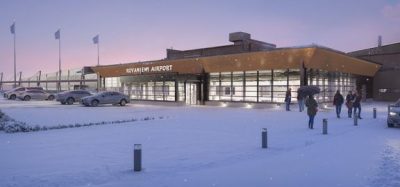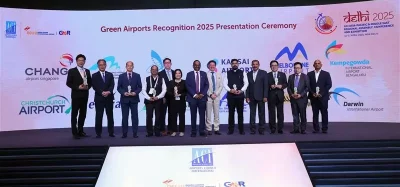Design & Architechture: Innovative Infrastructure
- Like
- Digg
- Del
- Tumblr
- VKontakte
- Buffer
- Love This
- Odnoklassniki
- Meneame
- Blogger
- Amazon
- Yahoo Mail
- Gmail
- AOL
- Newsvine
- HackerNews
- Evernote
- MySpace
- Mail.ru
- Viadeo
- Line
- Comments
- Yummly
- SMS
- Viber
- Telegram
- Subscribe
- Skype
- Facebook Messenger
- Kakao
- LiveJournal
- Yammer
- Edgar
- Fintel
- Mix
- Instapaper
- Copy Link
Posted: 9 October 2013 | Guillaume Sauvé, Chairman and CEO of ADPI | No comments yet
The completion of Dubai International Airport’s Concourse A was a huge achievement for the airport construction industry, explains Guillaume Sauvé, Chairman and CEO of ADPI.
The completion of Dubai International Airport’s Concourse A was a huge achievement for the airport construction industry, explains Guillaume Sauvé, Chairman and CEO of ADPI.
The need for airport infrastructure throughout the world is driven by the long-term air traffic increase. This offers considerable potential for development; enabling companies like Aéroports de Paris Ingénierie (ADPI) to thrive. ADPI is a whole subsidiary of airport operator Aéroports de Paris, and has achieved operational excellence in the field of engineering and design.
Since its creation in 2000, ADPI, which is made up of teams of architects and engineers, has successfully completed over 500 projects in 80 countries and is currently involved in over 100 projects, including the largest airport construction sites in the world.
Nowhere is this more evident than the Persian Gulf countries, particularly the United Arab Emirates, where ADPI has participated in a total of 2,200,000m2 of construction projects including airport terminals, control towers and maintenance hangars. As a result, ADPI is today seen as an indispensable, creative and dependable partner that is uncompromising when it comes to quality.
Dubai International Airport (DXB), the 10th busiest airport in the world with 57.7 million passengers in 2012, is one such airport that bears ADPI’s mark. ADPI designed the architecture and interior of DXB Terminals 2 and 3. The concept of Terminal 3 – developed together with Lebanese design office Dar Al-Handasah – was quite revolutionary. The available area, access road network and associated aeronautical infrastructure for the construction of the new terminal were insufficient. Therefore the design proposal comprised the construction of an underground terminal for all the passenger handling facilities, accessible via a road that would run underneath a large semi-circular canopy. The airport terminals, boarding piers, runways, taxiways, and control tower were built above these facilities to cope with the space constraints.
In addition to new construction, ADPI has also assisted with project management for complex expansion projects such as the new Concourse A in DXB Terminal 3; built to accommodate wide-body aircraft and opened in 2013. This terminal, used by Emirates, is the largest airport building in the world with a floor area of 1,500,000m2 and has the world’s largest concentration of A380 aircraft.
ADPI’s engineers designed and installed all functional and operational systems – from airport access to aircraft – to optimise airport procedures. These efficient and complex systems are unique. For example, the baggage sorter is able to handle 12,000 pieces of baggage per hour (departures and connections). To get to this result, ADPI built on the most effective technologies already in place in Satellite B (opened in November 2008) and carried out a value engineering study to make the project more efficient at a lower cost. ADPI’s engineers were able to find concrete solutions for every challenge. For example, the installation of an entire fibre optic network for IT systems; allowing us to go from 160 mechanical rooms to just 14. As with all our projects, to increase capacity without cost we simplify systems at reduce space requirements.
What differentiates ADPI from our competitors is our unique level of technical and operational expertise, which derives from being part of the Aéroports de Paris Group. Our approach focuses on creating value for our clients, and relies on a few key points: controlling costs and deadlines, optimising operations and securing the commissioning of the work, and maximising revenue and profitability generated by the investment. The projects completed in Dubai and throughout the world perfectly illustrate ADPI’s success in these fields.
Leading Architecture
New terminal in Mauritius
Inaugurated in August 2013, the new terminal at Sir Seewoosagur International Airport is the largest infrastructure ever built in Mauritius, at 56,900m2. The new terminal, which was conceived by Aéroports de Paris Management (also a wholly owned subsidy of Aéroports de Paris), was designed by ADPI.
Capable of handling up to 4.5 million passengers per year – an average of 1,640 passengers per hour during peak times compared with the current capacity of 750 passengers per hour – the new terminal features eight gate parking aircraft stands, including one specially designed to accommodate the A380. It is spread over three levels and houses 52 check-in desks less than 100m from the boarding lounges and 4,400m2 of duty free shopping.
The striking steel and glass roof structure was designed by ADPI to mimic the ‘Traveller’s Tree’ (ravenala palm), which is found all over Mauritius. The construction sets the standard for sustainable development encompassing 264 solar panels, rainwater recovery systems, natural lighting for public areas and green spaces, including tree-lined patios, vertical gardens and water walls.
Terminal optimisation in Brazil
In July 2013 it was announced that ADPI had been selected to take part in the renovation of the public areas at Guarulhos International Airport (GRU). GRU, situated in São Paulo, is Latin America’s busiest airport and handles 30 per cent of all Brazilian air traffic.
ADPI has been entrusted with improving the image and functional capabilities of the public areas at GRU’s two operational terminals which span 200,000m2. The three main tasks for ADPI are to optimise the airport capacity and functional capabilities; to enhance passenger comfort and experience; and to boost the airport’s revenue. The improvements are to be completed in time for the FIFA World Cup, which is being hosted in Brazil in 2014.
Complex and Efficient
With a floor area of more than 1,500,000m2, DXB’s Terminal 3 Concourse A and B complex is the largest building in the world.
What else makes it unique?
● Can carry 40 million passengers per year (70 per cent transfer passengers)
● 46 aircraft stands
● An internal elevator train
● 26 triple boarding bridges for A380s (including 20 on Concourse A)
● 12,000 bags can be handled per hour
Biography
Guillaume Sauvé has been the Chairman and CEO of ADPI (Aéroports de Paris Ingénierie) since 2012. He is an accomplished engineer and manager with a wealth of Project Management experience, both in France and internationally. From 2006-2011, Guillaume was Head of the Project Management Division at Aéroports de Paris; responsible for all investments at France’s three major airports (Paris-Charles de Gaulle, Paris-Orly and Le Bourget). On an international level, he managed the Project Team of ADPI in Dubai from 2002-2005; headed the design, supervision and project management of the new Emirates Engineering centre and the Terminal 2 expansion at Dubai Inter national Airport, and concurrently estab – lished ADPI Dubai Branch and its Design Office.
Guillaume has a degree in Engineering and Management from prestigious French academies Ecole Polytechnique and Ecole Nationale des Ponts et Chaussées. Before entering the airport industry, he worked for the French Government and the French Railway Authority.

















